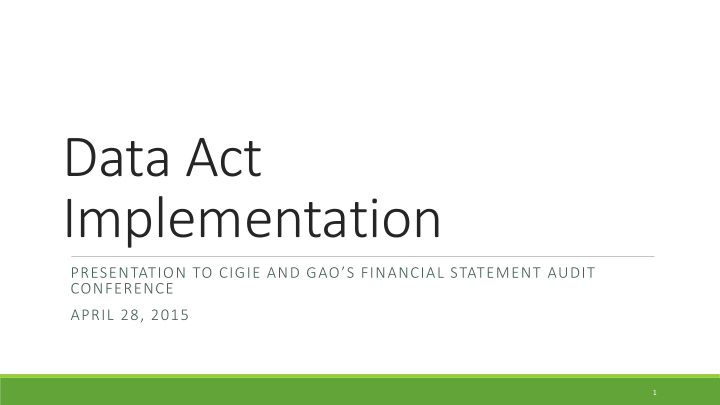



Data Act Implementation PRESENTATION TO CIGIE AND GAO’S FINANCIAL STATEMENT AUDIT CONFERENCE APRIL 28, 2015 1
DATA Act Summary Purpose: to establish government-wide financial data standards and increase the availability, accuracy, and usefulness of Federal spending information. Passed Congress on April 28. Signed into law on May 9, 2014 (P.L. 113-101). Amends the Federal Funding Accountability and Transparency Act (FFATA) to require full disclosure of Federal agency expenditures. Takes steps to simplify financial reporting and reduce recipient reporting burden. 2
Accountability and IG Community Involvement The DATA Act specifies that agency IGs must report on the “completeness, timeliness, quality, and accuracy of the data sampled and the implementation and use of data standards by the Federal agency” First report must be issued by November 2016 GAO required to report on government-wide implementation of the data standards by November 2017 3
Federal Spending Transparency: Goals Improve federal spending data quality across the government through effective implementation of the DATA Act Increase public access to federal spending information by refreshing the USAspending.gov website to be more user-friendly and transparent Work with federal and non-federal stakeholders to communicate our commitment to improving spending transparency and to stay informed of the public’s concerns and interests Develop a source of financial data that can be used with other datasets to improve decision-making across federal and non-federal organizations 4
Better data, better decisions, better government Agencies will have higher quality spending data and a more complete picture of where their federal funds go Management will have more data, more tools, and more insight into how to improve performance What can agencies do with these improvements? 5
Use financial data to make better management decisions Financial (spending) • Data-driven decisions data • More effective use of money • Understand how current spending is furthering agency Management goals systems 6
Target funding to recipients to maximize impact Focus funding by locality/municipality and/or targeting federal recipients to address exigent policy issues Align federal funds with other state, local, or other funding sources to maximize impact Improves management of funds by making explicit whether and how funds are spent and identifies opportunities for recipients to be active in managing their federal funds (e.g. imminent expiration of funds) 7
Improve operations and increase efficiency Will institutionalize better reporting of data Affords agencies a clearer picture of how funds are being spent Makes tracking, managing and handing off money more efficient 8
Respond to criticisms from watchdogs • Improved spending data will • Agencies will be better help identify areas of positioned to either defend duplication and waste against allegations of unnecessary spending, or to take actions to respond 9
Update on implementation: where we are and where we’re going • Working with stakeholders to develop data definition standards • Identifying necessary policy changes and implementation steps Current • Issuing policy guidance to agencies • Issuing financial data standards May 2015 • Issuing data exchange • Launching pilot to reduce reporting burden May 2017 • Ongoing standardization of data definitions • Agencies fully implement policy guidance and necessary systems changes • USA Spending refreshed to display additional spending data and beyond 10
Governance and Im Implementation Str tructure Executive Steering Committee – OMB and Treasury Inter-Agency Advisory Committee – OMB, Treasury, and Representatives from: CFOC, BOAC, ACE, COFAR, CAOC, CIOC, PIC, OSTP, GSA Design and Lead Support Consult Implement OMB Treasury Data Definition Standards Industry (Data Transparency Treasury PMO) Blueprint/roadmap between data elements Senior Treasury Non-Federal Accountable Officials from stakeholders Data Exchange Standards agencies OMB OMB Pilot to Reduce Admin Burden Federal Lines of Treasury Business Data Analytics
What’s next for agencies Organize team Review systems Design and strategize Map out necessary Within agency, identify Locate all 83 data elements changes and associated stakeholders and roles within systems costs Determine available Strategize how changes Analyze business processes resources and plan can be made to meet and data inventory coordination timelines Understand where likely Identify critical steps and changes will have to be potential challenges made 12
Moving forward: Collaboration with agencies OMB and • Share implementation plans and cost Treasury estimates • Provide feedback and insight on policies and standards • Provide feedback and guidance on agency plans • Collaborate with agencies to ensure that standards and policy are well formed and implemented Agencies 13
What’s next for IGs Monitor development of standards and policy issued by OMB and Treasury Stay aware of agency’s implementation and how your agency is planning and preparing Begin audit work sufficiently in advance of the November 2016 statutory deadline 14
Recommend
More recommend